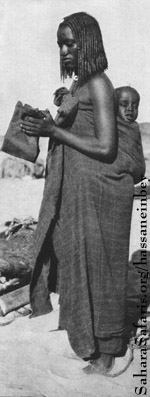BEDOUIN GUIDE TAKES BEARINGS BY STARS AND SHADOW
The manner in which a Bedouin guide finds his way
across the desert at night is a source of wonder to the uninitiated. In
a region which provides no familiar landmarks, he depends solely upon
the stars.
As we were proceeding in a southwesterly direction
during most of our night trekking the polestar was at the guide's back.
He would glance over his shoulder, face so that the polestar would be
behind his right ear, then take a sight to a star to the south in that
line. He would march for perhaps five minutes with his
(p274)
eye riveted on this star, then turn and make a new observation of the
polestar; for, of course, the star to the south was constantly
progressing westward. He would then select a new star for guidance and
continue.

A BIDIAT
MOTHER AND HER BABY
Her style of coiffure is almost
identical with that of the Tebu girl of Siwa (see page 250). Note the
nose bead. Her hair was plaited when she was young and has been oiled
from tone to time, but never combed out. [photo page 275]
One of the possibilities of losing one's way in the
desert, even when accompanied by a capable guide, may be due to the fact
that, after a long series of treks, when days are so hot as to provide
insufficient rest for the party, the guide may dose as he walks and thus
keep his eye fixed too long on the same star. His bearing in this way
shifts westward, out of the true line of march.
Knowing the method by which the Bedouin keeps his
direction, one is not surprised that, between sundown and the appearance
of the stars, he is completely lost and is a helpless figure in the
desert. At that hour of evening, and also in the early morning, when the
stars had disappeared but the sun had not risen, it was necessary for me
to take the lead, following my compass bearings.
 
|
